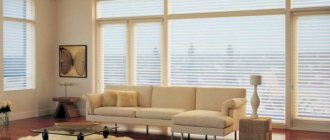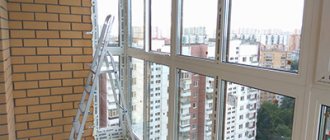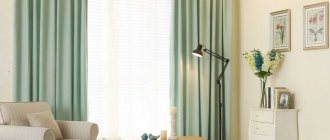Installation of any window system begins with carefully measuring the dimensions of the window opening. If the dimensions are taken incorrectly, it will be quite difficult to perform a high-quality installation, and in some cases even impossible. To avoid this, you need to immediately understand which GOSTs apply to PVC windows. Many live in standard houses, the sizes of windows of which are standardized. We invite you to get acquainted with the distinctive features of existing window systems and their overall dimensions.
GOST for PVC windows
Requirements for window blocks made of polyvinyl chloride profiles are established by GOST 30674-99. It says that such structures can be made with one-, two-, three-, four or more chamber profiles. Depending on the type of finish used, products are distinguished:
- white, colored in mass;
- for the design of which decorative film was used, i.e. laminated;
- with co-extruded coating on the front side.
GOST 23166 establishes uniform requirements for window blocks made of different materials. It states that according to the type of construction, plastic and other windows can be:
- single;
- paired;
- separate;
- separate-paired.
Depending on the number of valves, they are divided into single-leaf, double-leaf and multi-leaf. The systems differ in the direction of opening of the valves and the degree of opening. This allows the user to choose the option that suits him best.
The regulatory document states that classification by size is carried out on the basis of modular dimensions. In this case, it is customary to use a building module as the basis for model overall dimensions, which is designated by the letter M and is numerically equal to 100 mm.
For standard buildings as main ones, i.e. Modular sizes recommended for installation are:
- width: 6, 7, 9, 11, 12, 13, 15M, 18, 21, 24 and 27M;
- in height: 6, 9, 12, 13, 15, 18, 21, 22, 24 and 28M.
GOST states that the overall dimensions of a specific window unit are established by design documentation. They depend on the design features of the abutment units and the materials that should be used to fill the window openings. Information on the recommended ratio between the height and width of the structure is also provided here. We invite you to get to know her.
| Height Width | 580 | 860 | 1160 | 1320 | 1460 | 1760 | 2060 | 2175 | 2375 | 2755 |
| 570 | 6-6 | 9-6 | 12-6 | 13-6 | 15-6 | – | – | – | – | – |
| 720 | 6-7 | 9-7 | 12-7 | 13-7 | 15-7 | 18-7 | 21-7 | 22-7 | 24-7 | – |
| 870 | 6-9 | 9-9 | 12-9 | 13-9 | 15-9 | 18-9 | 21-9 | 22-9 | 24-9 | 28-9 |
| 1170 | 6-12 | 9-12 | 12-12 | 13-12 | 15-12 | 18-12 | 21-12 | 22-12 | 24-12 | 28-12 |
| 1320 | 6-13 | 9-13 | 12-13 | 13-13 | 15-13 | 18-13 | 21-13 | 22-13 | 24-13 | 28-13 |
| 1470 | 6-15 | 9-15 | 12-15 | 13-15 | 15-15 | 18-15 | 21-15 | 22-15 | 24-15 | 28-15 |
| 1770 | – | – | 12-18 | 13-18 | 15-18 | 18-18 | 21-18 | 22-18 | 24-18 | 28-18 |
| 2070 | – | – | 12-21 | 13-21 | 15-21 | 18-21 | 21-21 | – | – | – |
| 2370 | – | – | 12-24 | 13-24 | 15-24 | 18-24 | 21-24 | – | – | – |
| 2670 | – | – | 12-27 | 13-27 | 15-27 | 18-27 | 21-27 | – | – | – |
In addition to standard window units, the regulatory document establishes requirements for designs manufactured to individual orders. So, according to GOST requirements, the area of one window block should be within 6 squares. A limit has been set on the square of opening elements. Their area should be up to 2.5 sq.m.
Attention! In addition to squaring, the regulatory document limits the weight of one leaf or sash. It should not exceed 80 kg.
The choice of the maximum dimensions of the sashes is made taking into account the design features of a particular type of window products and their moment of resistance of the cross section, the selected opening pattern and a number of other parameters.
The maximum dimensions of opening sash elements and the calculated deflection (stiffness) of the bars of product elements are established in the regulatory and technical documentation for specific types of products, taking into account details, opening patterns, mass of opening elements and design operational (including wind) loads.
For a private home
An important advantage of private houses is freedom of choice. The choice of the size of plastic windows begins at the stage of developing design documentation. Many nuances that can affect the performance of the system are taken into account. Installation of one-, two- and three-leaf structures is possible. The calculation of the installed system is carried out according to standard methods, which greatly simplifies the work and guarantees high quality.
The technologies used allow us to implement a project of any complexity. The main thing is not to violate the standard proportions. The sizes of plastic windows installed in private houses comply with the regulatory requirements of GOST. When choosing, you just need to focus on the purpose of a specific room. For residential rooms, window systems of one size are preferable, for non-residential ones - another. Thus, in bathrooms, technical rooms, and kitchens, windows with smaller dimensions are installed.
You can separately provide several smaller window systems or one with larger parameters. The main thing is to ensure compliance with regulatory requirements for the maximum area. Thus, in brick and wooden houses, the size of the window block is chosen depending on the purpose of the room and the height of the ceiling. In the bathroom and toilet this parameter starts from 0.3 m, in the kitchen - from 0.9 m, in living rooms from 0.8 and in the attic from 1 m.
Why are standards needed?
GOST is a standard adopted by the state and establishing clear requirements for the characteristics of products, services, and work performed. Quality criteria are established based on existing scientific achievements, experience, methods, and international standards.
They are needed to standardize products so that all enterprises produce products of the same high quality, safe and wear-resistant.
Standardization simplifies the work of designers of multi-storey residential buildings and other standard buildings, freeing them from additional calculations. Standard designs are easier to replace if necessary.
Residential buildings look harmonious from the outside with a glazing area that is approximately half of the total façade area.
For Khrushchev
A fairly common option. Typical high-rise buildings of this type were built from 1956 to 1980. The builders offered two standard options: 5 and 9 floors. Initially it was assumed that this housing would be temporary. Its service life was limited to 20 - 50 years. By this time, the management was confident that all residents of the Khrushchev-era apartments could be moved to more comfortable apartments. However, such grandiose plans did not fully come true. Numerous Khrushchev buildings are found in large numbers in the post-Soviet space.
The window systems installed in such houses have the following dimensions:
| View | Height, mm | Width, mm |
| Bivalve | 1340 | 1280 |
| Tricuspid | 1340 | 2030 |
| Balcony block | 2030 | 2070, with door width 680 |
Brezhnevka
Houses of this type were built over a long period of time: from 1965 to 1991. Depending on the project, the number of floors varies from 5 to 12. The largest part of the houses belonging to the economy class category belongs to this category. Such buildings have a wall thickness of about 510 mm. The ceiling height is unified and is 2640 mm. Each apartment has a small balcony and a separate bathroom, which many owners then combine.
The dimensions of the window blocks are as follows:
| View | Height, mm | Width, mm |
| Bivalve | 1520 | 1280 |
| Tricuspid | 1520 | 2080 |
| Balcony block | 2070 | 2030, with door width 680 |
Stalinka
The construction of such houses began back in 1930 and continued until the early 1960s. The number of floors in such buildings was chosen from the range 1 – 10. Load-bearing walls were built from brick. At the same time, the ceiling height inside the room reached 3 meters. Gradually, these projects began to be abandoned in favor of more economical options.
The dimensions of the window blocks are as follows:
| View | Height, mm | Width, mm |
| Bivalve | 1950 | 1150; 1400 |
| Tricuspid | 1950 | 1700 |
| Balcony block | 2700 | 1400 |
What profiles are used
Typical construction assumes standard sizes of window openings, determined by SNiPs and GOSTs, which take into account:
- room size;
- type of premises (non-residential or residential);
- intensity of natural light;
- window light transmission.
The standard, or rather the most common, is considered to be a plastic window made from a class “A” PVC profile, equipped with one-, two- or three-chamber double-glazed windows and fittings for opening and closing.
In the production of PVC window blocks, three types of profiles are used:
- class “A” with a thickness of internal walls of 2.5 mm, external walls - 2.8 mm;
- class “B” with a thickness of internal walls of 2 mm, external - 2.5 mm;
- all other types are combined into class “C”.
The thicker the walls, the warmer and stronger the profile, so class “C” models are not used for glazing residential premises. The strength of the structure is also affected by the presence of metal reinforcement inside the profile - reinforcement. The preservation of heat inside the room also depends on the number of chambers in the profile - the more there are, the warmer the room.
Houses of various series
In addition to buildings with characteristic names that allow them to be attributed to a specific period of construction, there are a number of standard series. These buildings were erected at different times and have their own distinctive features. We invite you to get to know them.
Ships 1Lg-600
Design documentation for this series was developed in the 60s in Leningrad with a focus on the northern capital. Here they mainly used the standard project. Construction began in 1969 and continued until 1989. The number of floors was selected individually. Buildings with 5 to 15 floors were erected. The panel walls of houses in this series have brick inserts. Thanks to them, it was possible to dampen the strength of the coastal wind quite well.
The dimensions of the window blocks are as follows:
| View | Height, mm | Width, mm |
| Tricuspid | 1420 | 2690 |
| 1130 | 2380 | |
| Balcony block | 2200 | 1800 with door width 700 mm |
Episode 121
Another series that has been actively used in the construction of large-panel residential buildings since 1970. It has not lost its relevance today. The number of floors is mainly 3–9. However, in some regions you can also find 12-story buildings. The house uses reinforced concrete floors. The main disadvantage of this series, which most residents complain about, is the low level of sound insulation. Despite this, the project does not lose its relevance.
Large-panel buildings. Their story began in 1970. And it's still not over. Number of floors: from 3 to 9. But there are also rare 16-story buildings. The main disadvantage is poor sound insulation.
The dimensions of the window blocks are as follows:
| View | Height, mm | Width, mm |
| Bivalve | 1410 | 1450 |
| Tricuspid | 1420 | 1700 |
| Balcony block | 2050 | 1440 |
Episode 137
The construction of houses in this series was completed relatively recently. They were actively erected from 1974 to 2015. The number of floors was chosen mainly from the range 9 – 16. However, 18-story buildings were also erected. Most often, series 137 was built in St. Petersburg. However, the project was also implemented in Orel and Volgograd. The apartments have a separate bathroom. The kitchen area is 8 - 15 square meters.
The dimensions of the window blocks are as follows:
| View | Height, mm | Width, mm |
| Bivalve | 1420 | 1150 |
| Tricuspid | 1420 | 1700 |
| 1440 | 2050 | |
| Balcony block | 2140 | 1880 with door width 680 |
Series 504
The standard project was implemented from 1969 to 2001. More often, the choice in its favor was made in Chelyabinsk and St. Petersburg. By their nature and area, apartments in houses of this series are an improved version of Brezhnevka apartments. Large panels are used to build walls. Number of floors: 5, 9, 10 and 12. Parquet is provided as flooring. Residents can take advantage of spacious loggias. A distinctive feature of residential buildings of the 504 series is their good sound and heat insulation, which is a significant advantage compared to other projects.
The dimensions of the window blocks are as follows:
| View | Height, mm | Width, mm |
| Bivalve | 1410 | 1450 |
| Tricuspid | 1420 | 1700 |
| Balcony block | 2140 | 1180 with door width 680 |
Series 600.11
Improved version of 1Lg-600. A distinctive feature is the L-shaped shape of the kitchen window. Due to the changes made, it became possible to install an air conditioner with standard dimensions in the window vent. The number of floors in the house differs. Selected from 4 – 11. The houses were built over a long period: from 1982 to 2015.
The dimensions of the window elements are as follows:
| View | Height, mm | Width, mm |
| Bivalve | 1410 | 1450 |
| Kitchen | 1440 | 1850 |
| Window | 550 | 870 |
| Tricuspid | 1420 | 1700 |
| Balcony block | 2140 | 1880 with door width 680 |
Series 602
The houses were erected during the reign of Brezhnev. Includes 5 or 9 floors. Found in St. Petersburg, Riga and Naberezhnye Chelny. Active construction took place from 1966 to 1982. Elevators and garbage chutes were already provided inside. There were loggias along the side ends. Polymer, glass slabs, and ceramics were actively used as decorative materials for wall decoration.
The dimensions of the window blocks are as follows:
| View | Height, mm | Width, mm |
| Bivalve | 1530 | 1450 |
| Tricuspid | 1530 | 2230 |
| Balcony block | 2070 | 2030 with door width 680 |
Series 606
Most often, such high-rise buildings were built in St. Petersburg from 1966 to 1974. Each floor has 6–7 apartments, depending on the number of entrances. Bathrooms are separate. There is parquet on the floor. Expanded clay concrete was used to construct the walls. The ceiling height in the apartments is 2.7 m.
The dimensions of the window blocks are as follows:
| View | Height, mm | Width, mm |
| Bivalve | 1530 | 1490 |
| Tricuspid | 1520 | 2080 |
| Balcony block | 2070 | 2030 with door width 680 |
Wooden window blocks with simple glazing
Wooden window blocks for individual residential buildings with simple glazing can be made structurally:
- single;
- paired.
Wooden window block:
- a - with double glazing in a single frame;
- b - with double glazing in a paired frame,
- where 1 is window glass; 2 - frame; 3 - window frame; 4 - galvanized steel casting
The single design of window blocks is used in interior and unheated rooms. During installation, the doors are hung directly on the product box. In window blocks of a paired design, the outer sashes are attached to the inner sashes using various types of hinges. The outer and inner sashes are additionally fastened together; locking devices and handles are installed on the internal doors.
For the above structures, the permissible dimensions of opening sashes should not be more than 1200 mm in width and 1800 mm in height.
Glass is installed with waterproof sealants. Corner and middle connections of frame elements must be made on double or triple straight tenons with glue.
Bivalve
Universal models that are most widespread. This is the best option for a one-story private house, an apartment in a high-rise building, an office space, or a public building. Based on the name, it consists of a base - a frame on which two doors are attached.
The sizes of double-leaf structures vary widely. If systems with slightly larger and smaller dimensions. The most popular sizes are 1150 by 1900 mm, 1300 by 2200 mm, 1500 by 1900 mm.
The design of the window may vary significantly. Some choose a design with only one opening door. Others prefer the option with two opening panels. The order of operation and possible operating modes are determined at the design stage and subsequent manufacturing. In most cases, subsequent modification is impossible due to the nature of the fittings used.
Tricuspid
Such structures are installed in large rooms. Their distinctive feature is their large overall dimensions. Due to this, a lot of sunlight enters the room and creates a comfortable environment for relaxation.
The design of the windows themselves may differ significantly. Such structures consist of a frame and three doors. The dimensions and operating order of such structural elements may vary significantly. In one case, the central leaf is fixed, and the side ones are made to open; in the second case, on the contrary, the side one is fixed, and the central one can open.
From the point of view of ease of use and maintenance, the first option is preferable. When washing glass, you have access to all structural elements.
If only the central part opens, it is made a little wider, and a brush on a telescopic handle is used to access remote areas.
From the point of view of ease of use and safety, models in which all three doors open are preferable. However, due to the need to use additional fittings, such a system is of limited use.
The dimensions of the window block are selected taking into account the dimensions of the opening. Standard heights are considered to be: 1200, 1350, 1500, 1170, 1320, 1470 mm. The width also depends on the opening and is 1800, 2100, 2070 and 1770 mm.
The dimensions of the sashes are selected depending on the design features and personal preferences. They can all be made the same width or the proportions can be changed.
Dimensions of fixed windows
If the dimensions of fixed windows do not exceed 800x400 mm, then no restrictions are imposed on their use. In all other cases, you must be guided by GOST 23166-99, which states that the installation of any fixed windows in rooms above the first floor is prohibited if their dimensions exceed the maximum permissible values. The only exceptions are openings facing balconies and loggias. As for the possibility of installing blind structures on non-residential properties, issues are considered individually on the basis of design documentation.
Non-standard
Installing a standard rectangular or square window block is not always possible. In such a situation, it is necessary to make custom-made plastic windows, adjusting them exactly to the dimensions of the existing opening.
Modern technologies make it possible to create a structure of any size and shape. However, when planning the development of an individual project, you should remember the current restrictions:
- maximum quadrature of a fixed window is 6 squares;
- the maximum height of the structure with opening doors is 2.2 m;
- a fixed window cannot be less than 0.3 by 0.4 m, and a casement window 0.4 by 0.5 m.
Knowing these features, you can begin to develop design documentation. In this case, it is necessary to be guided by the requirements established by regulatory documents. For the nursery, bedroom and living room, you can safely choose a design with maximum dimensions. For the utility room, kitchen and bathroom - with minimal ones. The area of the window itself is selected taking into account the internal space. The light coming from outside should be sufficient for a particular room. So, for a nursery or bedroom with an area of 10 - 12 square meters, order a window block measuring 0.9 by 0.9 m. With a larger square footage, either the size of the mounted structure or the number of windows themselves is increased.
Why is it important to identify and choose correctly?
As a rule, this data is needed in order to qualitatively replace double-glazed windows in an existing PVC window.
This replacement may be due to mechanical damage, seal failure, or the need to install a new energy-efficient package.
The correctly selected size will help to efficiently install the new package while maintaining the functionality of the main window components.
Knowing the size, you can determine the acceptable glass formula for selecting it on the market, and you can strengthen its protective characteristics, for example, by replacing the glass thickness from 4 to 6 mm, or replacing a two-chamber glass with a three-chamber one, if the thickness of the old package allows. If you cannot find a three-chamber package based on this indicator, you can simply install energy-efficient glass.
How to measure yourself?
There are several options by which you can quite accurately determine the size of a double-glazed window, without disassembling the PVC window:
- Measure the distance between the width and height of the package along the glazing groove exactly to 1 mm and subtract 10 mm from the resulting value. This size determines the deformation gap between the glass and the PVC frame. To prevent the package from breaking due to temperature expansion. For example, the width along the groove is 485 mm, then the double-glazed window will have a width of 485-10 = 475 mm.
- Next, measure the thickness of the bag; the easiest way to do this is by looking at the window passport or contract; this characteristic will be indicated there, for example, for a 32 mm two-chamber bag.
In most cases, this characteristic is indicated on the spacer bar.
You can also measure the width of the PVC frame and calculate the width of the double-glazed window using the formula:
Ш st = Sho - Asn - Asi,
Where:
- W st - width of the glass unit in mm;
- W o - window width in mm;
- Asn - distance from the frame to the glass outside, mm;
- Asi - distance from the frame to the glass from the inside, mm.
For example:
- W st - width of the glass unit in mm;
- W o - window width 40 mm;
- Asn - distance from frame to glass outside, 4 mm;
- Asi - distance from the frame to the glass from the inside, 4 mm;
- W st = 40 - 4- 4 = 32 mm.
Almost all serious window companies have a laser device for determining the thickness of a PVC window. The glass unit size determined by the instrumental method will be the most accurate.
Tips for choosing
Selecting a suitable window unit is associated with a number of difficulties. When choosing a suitable model, you have to take into account many nuances. This will allow you to choose a design that will not only “fit” into the window opening, but will also cope perfectly with the task.
Glass packages
The energy efficiency of the window unit, its soundproofing characteristics, burglary resistance, light transmittance and, of course, appearance depend on their design features. Double-glazed windows can have 1 – 3 chambers filled with krypton or argon. Due to the use of inert gas, the thermal insulation properties of the structure are increased and the noise-absorbing properties are improved.
The purpose of a double-glazed window directly depends on its design features. Thus, the budget category with 1 – 2 cameras, equipped with 4 mm thick float glass, is distinguished by its light transmittance. This is a suitable option for buildings erected in a region with a warm climate, a country house.
Impact-resistant double-glazed windows are equipped with heat-strengthened or tempered glass of different thicknesses and triplexes. This is a suitable option for children's rooms, living rooms and all other rooms located on the ground floor. Those who want to reduce heating costs will like energy-saving double-glazed windows. Thanks to the installation of special glass, such structures transmit rays of the visible spectrum, but retain thermal waves.
Special multifunctional models help retain heat in the house and prevent excess sunlight from penetrating inside. This innovative development is ideal for rooms with a large glass area facing the sunny side.
Another non-standard solution is heated double-glazed windows. They contain electrochromic glasses, the surface of which is covered with a layer of crystals that darken the surface. When voltage is applied, double-glazed windows begin to generate heat. This is a good option when choosing an additional heat source.
When choosing a double-glazed window, you should remember that choosing an additional chamber or triplex will increase the weight of the product by 40%. This will negatively affect the operating conditions of the fittings, which will have to meet certain requirements for strength characteristics.
Automation
Plastic windows with an automatic opening system are quite comfortable to use. This is a suitable option for people with disabilities. The choice in favor of automation is made when glazing with high openings and there is an increased wind or snow load.
Most automatic systems can be controlled using a remote control or a special application. This allows you to adjust the mode of ventilation of the room when the owner of the house is absent.
Accessories
An important element that deserves the closest attention when choosing. The convenience and duration of operation of the window system as a whole depends on its technical characteristics. For massive sashes, you should choose durable, reliable fittings that can withstand the weight of the swing element. Otherwise, after a certain period of operation, the sash will sag.
When choosing accessories, you should not save money. The lifespan of a window system largely depends on its quality. Budget models have a limited lifespan and will soon have to be replaced. Higher quality analogues can last longer.
Type of opening system
An important characteristic, the choice of which depends on the purpose of the window unit. Highlight:
- tilt-and-turn, which is a universal option used to complete standard window units;
- parallel-sliding or sliding, which is chosen for balconies;
- swing, which is a universal option and can be installed everywhere;
- lifting or folding, which is found in fairly high openings;
- mid-hung, which was originally developed for window units with a horizontal or vertical axis of central opening.
There are other types of window openings. A complete list of them can be found on the website of most leading manufacturers. It must be remembered that the more complex the mechanism, the more expensive its installation and subsequent operation will be.
Additional ventilation
An important selection criterion that is of fundamental importance in the off-season and winter. At this time, it is not always possible to open the doors to ventilate the room. The lack of fresh air flow negatively affects the microclimate inside a house or apartment. To avoid this, you should initially choose plastic windows equipped with additional ventilation elements. This may be a mortise valve or a micro-slit ventilation device.
Window appearance
Manufacturers offer window systems with various design options. You can choose not only a white profile, but also any other color. This allows you to choose the best option depending on the installation location and the chosen stylistic solution.
Thus, the manufacturers' catalogs present a large number of plastic windows, differing in size and technical characteristics. When starting to choose a suitable option, you need to know exactly the dimensions of the window opening and the requirements for the design. In this case, you will definitely be able to install systems that effectively cope with the task.
Double-glazed glass thickness
Double-glazed glass thickness
, like any other, is determined primarily by the profile of the window frame. The wider its thickness, the better it retains heat. The thickness of a double-glazed window is the sum of the thicknesses of three glasses and two distances between them.
Whatever the sizes of the components, in total they can be of four sizes:
- 60 mm - used in difficult climatic conditions;
- 40, 32 and 24 mm - used in temperate climates.
Not only the thickness of a double-chamber double-glazed window determines its thermal conductivity. The use of glasses with additional coating (i-glass or k-glass) and filling the space between them with inert gases (argon (Ar) or krypton (Kr)) increases this indicator. The use of glass and distances of various thicknesses gives it anti-resonance qualities, increasing sound insulation.










